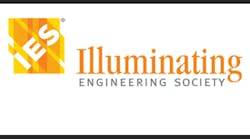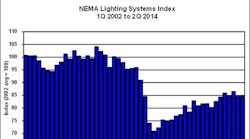The National Lighting Bureau, Silver Spring, Md., speculates that technology may be at least partly to blame for the lack of significant-overall change (a 0.1% increase) between first- and second-quarter 2014 lighting-equipment demand as measured by the National Electrical Manufacturers Association’s Lighting-Systems Index (LSI).
“The LSI results for the first two quarters of 2014 are more or less what they were during the last quarter of 2008,” said National Lighting Bureau Executive Director John Bachner. “First-quarter 2014 LSI performance declined from the previous quarter’s and we ascribed the shrinkage to the bad weather that affected so many elements of the U.S. economy. But more may have been happening than we supposed. And if we’re right, it may not be all that bad, because it would demonstrate that Americans are opting for greater lighting efficiency and longer lighting life.
“We may be entering a ‘new normal,” Bachner said. “For example, incandescent A-lamps have fallen to a 34.7% share of the screw-in-base consumer-type lamps market, principally because they may no longer be manufactured in or imported to the United States. Most of the ‘slack’ is being picked up by CFLs (compact-fluorescent lamps), which now comprise a 36.4% market share. Because CFLs last six or more times longer than incandescent A-lamps, there will be far less need for replacement bulbs in that market. In the commercial and industrial markets, the demand for new and replacement ballasts will also be declining, spurred by growing reliance on LED technology, which makes ballasts unnecessary.”
New-building construction may also be morphing its normalcy, at least insofar as investment capital is concerned, he said. “Right now, the emphasis is on nonbuilding construction -– especially infrastructure -– which uses relatively little lighting. As it so happens, however, the public’s need for upgraded, expanded, and new infrastructure far exceeds the public’s ability to pay for it, and that’s encouraging far more reliance on public/private partnerships (P3s). The extent to which money invested in P3 projects results in less money for building-construction investment remains to be seen.”
Bachner said that, in his opinion, it might take another year or more to determine if a new normal truly is in place and, if it is, what it looks like. “No matter what it looks like,” Bachner quipped, “People will need lighting to see it, and that lighting will become steadily more efficient and longer-lived. That’s a good thing.”
Using 2002 data to create its 100-point benchmark, NEMA’s LSI (www.nlb.org/Index/) is a composite measure of luminaires, ballasts, miniature lamps, large lamps, and emergency lighting shipped throughout the United States by the lighting-equipment manufacturers of the National Electrical Manufacturers Association (NEMA). NEMA adjusts the Index for seasonality and inflation.
Established in 1976, the National Lighting Bureau is an independent, IRS-recognized not-for-profit, educational foundation that has served as a trusted lighting-information source since 1976. http:










